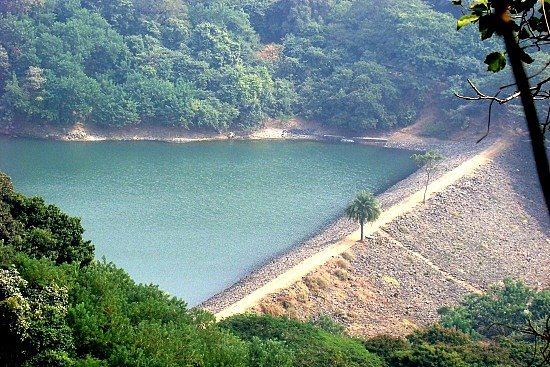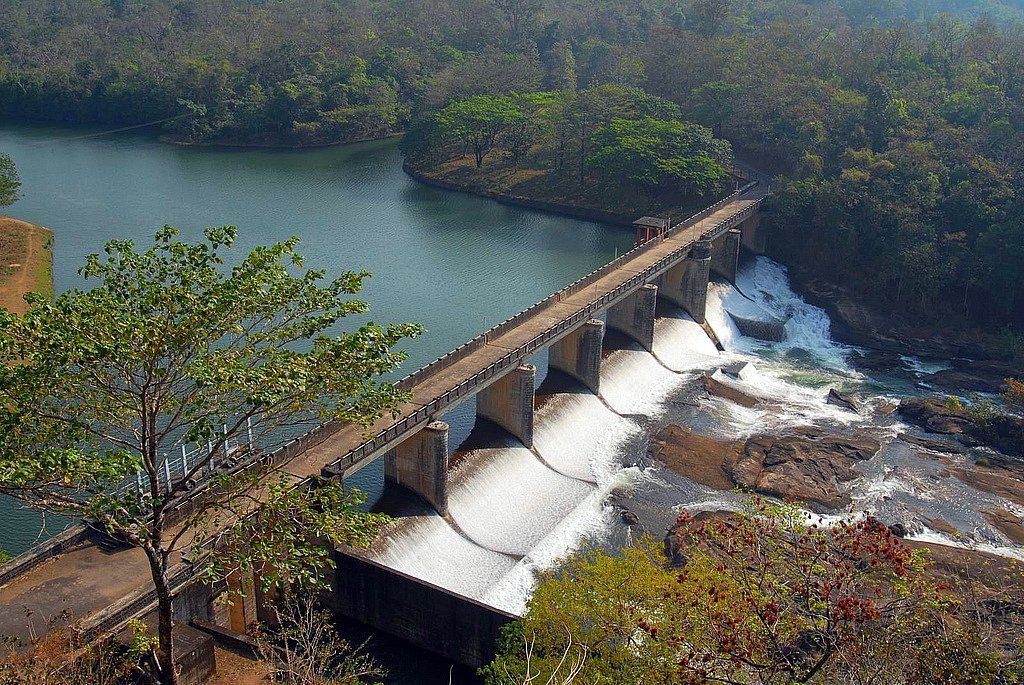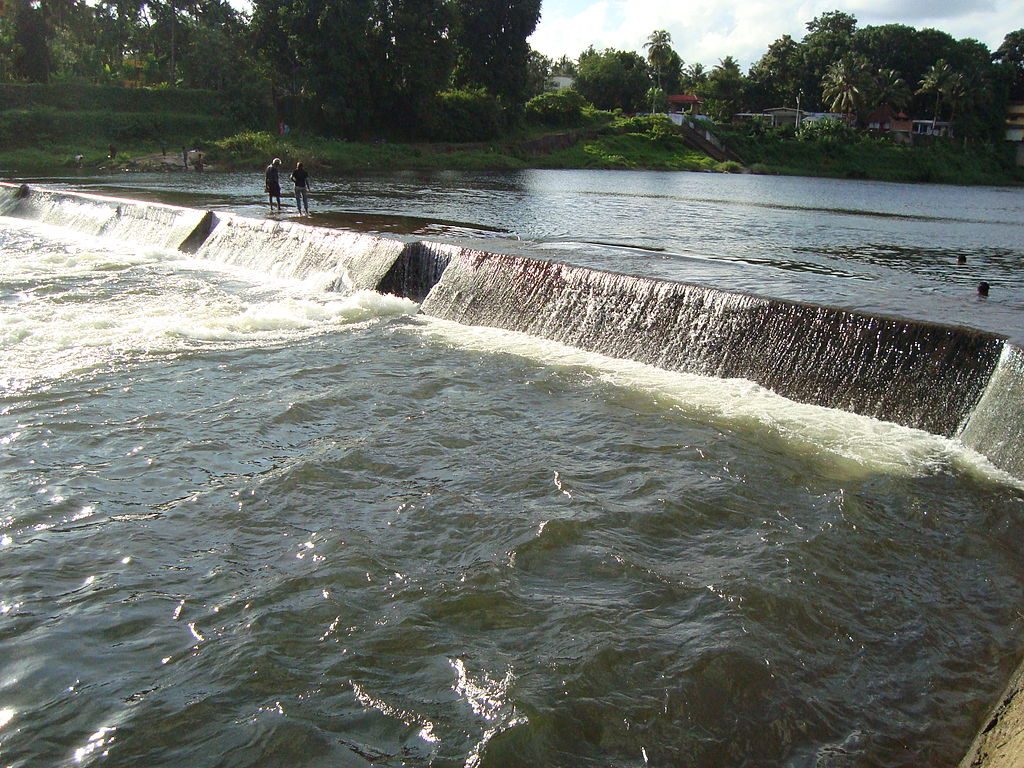A check dam is a small, at times a temporary dam constructed across a seasonal stream, drainage ditch, or waterway to counteract erosion by reducing water flow velocity. Check dams are simple and effective. They reduce stop the flow of the water till it reaches the height of the dam and overflows. The resulting accumulation of water serves to recharge the ground water table better and to prevent the erosion of soil. Check dams themselves are not a type of new technology; rather, they are an ancient technique dating from the second century A.D.

Plastic modified mortar Check Dam at Anandwan under the guidance of Dr. Vikas Amte 
Check Dam Aathukadu, Tamil Nadu 
Check Dam at Palayam, Tamil Nadu 
Check Dam on Elephanta Island 
Check Dam across Kallada in Kollum district of Kerala 
Koodapuzha check dam in Kerala on the Chalakudy River 
Check Dam in Rajasthan
What are check dams?
Check Dams can be boulder dams or rock check dams. Simply explained, they are obstructions to flowing water in order to cause it to be retained. Smaller, temporary check dams can be constructed out of virtually any material that is strong enough to withstand the flow of water and does not leach harmful substances into the water. In the process, small green areas are formed that counteract desertification and water scarcity, aid water conservation and improve the local natural environment in addition to being a store of rain water or snow melt that can be used for irrigation or other purposes. Old truck tires, plastic waste and other waste material can be effectively repurposed toward low cost environmental engineering.
What is the purpose of check dams?
The purpose of check dams is to retain water up stream, so that the water percolates into the ground and recharges the ground water table. As concerns arise around large dams and environment, check dams are proving their worth over and over. Check Dams built on seasonal rivers, stop rain water discharging into the sea or going waste and provide natural fresh water bodies for local use as well as strengthening ecosystems. Check dams also serve to trap sediment and pollutants, strengthen local bio-diversity and help improve the overall quality of the water.
Where to construct check dams and their uses?
Check dams can be constructed by blocking the flow of water at a suitable spot. The stream or other flowing water should have clear banks on both sides, so that the check dam causes the water to collect. The banks should be higher than the desired height of the dam, or the water will simply flow around your dam and divert the stream. Once a suitable location is identified, a dam can be constructed out of any sturdy material that will withstand the force of the flowing water and not let it pass through. Large obstructions like boulders or waste tires can be sued to give it strength and mud, gravel or concrete can be used to prevent water from passing through. Waste plastic or tarpaulin sheets too can be used to make temporary dams waterproof.
The resulting water can then be repurposed for irrigation, drinking water for cattle or even pumped and filtered to provide household and drinking water.
Check dam construction – how to build a check dam?
Check dam design: No complex engineering design or supervision is involved in check dam design and yet the impact on the ground water table can be dramatic. Check Dams can have a width of 5 feet and the height should not be more than 5 feet at any point from the river bed. That means the check dam will follow the contour of the river bed. The side slopes of a rock check dam can be 1 vertical to 1.5 horizontal. The objective is not to create a reservoir and exceed banks or submerge adjacent land, but to provide a point for the water to slow and permeate through the ground and replenish increasingly threatened ground water tables.
That means the bottom of the dam should be around 20 feet wide, sloping upwards at 1:1.5 to get a width of 5 feet on the top.
The foundation should be concrete, say around 1 feet high. (Where river bed is hard murrum or rock foundation avoided). Lay boulders, the heavier ones below and fill the voids with stone chips. Cement mortar 1: 6 can be used upto a height of 2.5 feet after which 1:8 mortar is fine. The voids between boulders need to packed with stone chips and low strength mortar.
Check dam design: No complex engineering design or supervision is involved in check dam design and yet the impact on the ground water table can be dramatic. Check Dams can have a width of 5 feet and the height should not be more than 5 feet at any point from the river bed. That means the check dam will follow the contour of the river bed. The side slopes of a rock check dam can be 1 vertical to 1.5 horizontal. The objective is not to create a reservoir and exceed banks or submerge adjacent land, but to provide a point for the water to slow and permeate through the ground and replenish increasingly threatened ground water tables.
That means the bottom of the dam should be around 20 feet wide, sloping upwards at 1:1.5 to get a width of 5 feet on the top.
The foundation should be concrete, say around 1 feet high. (Where river bed is hard murrum or rock foundation avoided). Lay boulders, the heavier ones below and fill the voids with stone chips. Cement mortar 1: 6 can be used upto a height of 2.5 feet after which 1:8 mortar is fine. The voids between boulders need to packed with stone chips and low strength mortar.
Alternatively, check dams have also been created from logs, discarded truck tires and even sandbags. Virtually anything that can be stacked to block water which is sturdy enough to not drift or decay and does not leach harmful chemicals can be used to create a check dam.
Once the dam is built, secure all open faces with wire mesh, anchored to the foundation or ground for added durability.
The purpose of the dam is just to impede the flow of water and create a small reservoir to serve local needs and environment. What ever water remains trapped on the river bed, will recharge the ground water level. In case of flash flood, check dams provide slight resistance to the flow of water without actually stopping it. The flood passes over the dam, like regular water. If the flood is very heavy part of the dam may give way. So maintain it. My experience does not cause flooding of the banks. Dam stays well if maintained and the costs of maintenance are low.
Such Check Dams can be build every 3 or 5 km along seasonal water courses and will go a long way toward improving year round water availability in our country, which is predicted to have severe water scarcity in another decade or two. Studies have shown that the ground water table rises sufficiently after 2 seasonal entrapments.
It is also cost effective. In the cost of one major hydro electric project, or two, we could build check dams on most seasonal streams and make a significant dent in the problem of water availability.
Being labour intensive, check dam construction provides productive work for neighborhood and results in restoration of ground water and strengthening of eco-diversity that lead to further sources of income. Check dams increase the availability of water for agriculture – an important factor for better yields in a country and world where food production is also an important objective. They could serve as MNREGA projects and provide crucial employment in a difficult economy.
Large dams entrap large amounts of water which percolates into the ground and makes the soil water logged and less fertile. Their large size results in trapping of heat and changes local climates. Not so with check dams.
Check dams are a cheap method to conserve water, rejuvenate falling water tables, support the ecology and fight the ever present threat of drought. In an increasingly polluted and water insecure world, check dams are a quick and effective way of reversing the clock.
Article written in collaboration by Jagannathan Sathyamoorthy @SathyMJ

